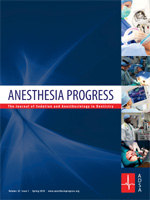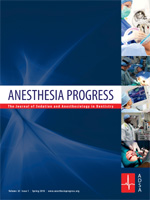[ad_1]

Anesthesia Progress volume 68 issue 2
In our study, we found administering nitrous oxide reduced the pain of the dental injection and increased the likelihood of anesthesia.
LAWRENCE, Kansas (PRWEB)
July 14, 2021
Anesthesia Progress – The most common reasons people do not visit the dentist regularly is fear of dental pain, making effective anesthesia essential to proper patient care. Given that between 10 percent and 39 percent of patients have reported ineffective pulpal anesthesia, finding the correct local anesthetic can increase confidence in dental visits and assist people in more regular oral healthcare.
Researchers from the Ohio State University, Columbus, Ohio, recently published a double-blind, crossover study in the current issue of Anesthesia Progress that compared the effects of nitrous oxide/oxygen (N2O/O2) with that of room air/oxygen (air/O2) on inferior alveolar nerve block (IANB) injection pain and mandibular pulpal anesthesia success.
At two separate appointments, approximately one week apart, a total of 105 patients either received N2O/O2 or air/O2 followed by an IANB injection. Before the injection, each patient rated the anxiety level based on the Corah dental anxiety scale. After the injection, patients were asked to rate their pain at each of three injection stages, including needle insertion, needle placement, and solution disbursement, using a visual analog scale. Finally, over a 60-minute period, pulpal anesthesia was evaluated using an electric pulse tester on the mandibular first and second premolars and molars, while the canine served as the unanesthetized control.
The researchers found an overall low anxiety rating across all patients before the procedure. They also recorded that the mean pain scores were lower for the N2O/O2 group compared with the air/O2 group, which was mild or moderate for each injection stage. The success rate of the IANB injection, creating an increased likelihood of pulpal anesthesia, was also higher in the N2O/O2 group for all 4 tooth types evaluated; however, pulpal anesthesia was not reported at 100 percent.
On the findings of this study, Dr. Reader concludes, “Fear of pain is the number one reason people give for not making regular visits to the dentist. Reducing the pain of a dental injection, and having the patient experience no pain during the dental visit has always been important to the practicing dentist. In our study, we found administering nitrous oxide reduced the pain of the dental injection and increased the likelihood of anesthesia. We feel these findings are important to every practicing dentist.”
Full text of the article, “Nitrous Oxide/Oxygen Effect on IANB Injection Pain and
Mandibular Pulpal Anesthesia in Asymptomatic Subjects,” Anesthesia Progress, Vol. 68, No. 2, 2021, is now available here: https://doi.org/10.2344/anpr-68-01-10
###
About Anesthesia Progress
Anesthesia Progress is the official publication of the American Dental Society of Anesthesiology (ADSA). The quarterly journal is dedicated to providing a better understanding of the advances being made in the science of pain and anxiety control in dentistry. The journal invites submissions of review articles, reports on clinical techniques, case reports, and conference summaries. To learn more about the ADSA, visit: http://www.adsahome.org/.
Share article on social media or email:
[ad_2]

